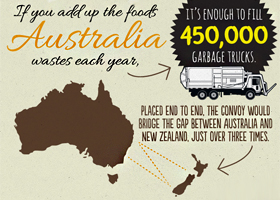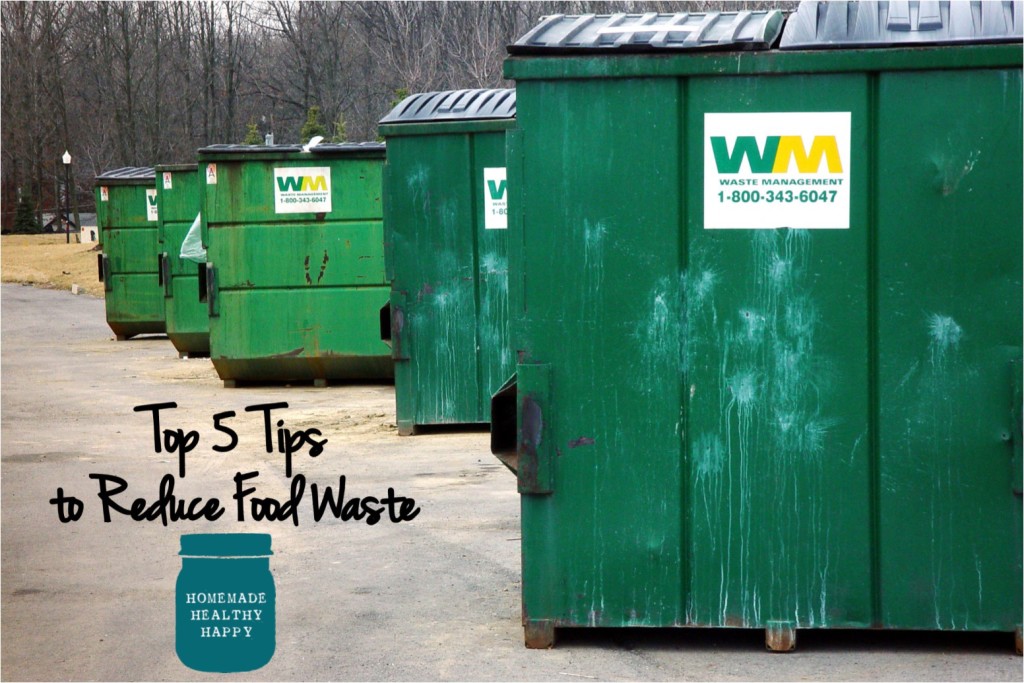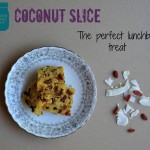Food waste is my absolute, all time, most enormously huge pet peeve. I can’t stand it. I don’t like to over-use the word ‘hate’, but… I hate food waste.
And food waste occurs from the farm to the plate. It. drives. me. crazy.
 Click here for an alarming graphic on food waste in Australia, courtesy of lunchalot.com
Click here for an alarming graphic on food waste in Australia, courtesy of lunchalot.com
The thing is, it’s everywhere you turn. Supermarkets (well, the middlemen in between farmers and supermarkets, really) won’t take ugly produce. Crooked cucumbers. Small avocados. Wonky eggplants. Farmers can’t offload them, so they get wasted. If anything escapes the beauty checks along the way, and a piece of less-than-perfect produce ends up at the supermarket, it gets ditched there. If someone picks up a bunch of 6 bananas, only wanting 5, and rips one off to leave behind – other people won’t buy single bananas and eventually that lonely one gets ditched. If something gets a bad spot, it’s not marked down – ditched. And this is only some of the waste happening in our food supply.
It doesn’t even touch on what happens when we get food home. I don’t think I need to go through the list of things like carrots that go a little soft, bananas left to over-ripen, half bunches of herbs that wilt or go mushy, lunchboxes hardly touched by little fingers, dinners scraped into the bin, and a whole lot more.
So. much. waste.
It frustrates me. Sometimes I just feel like I can’t care any more, but then I find I’m not actually capable of not caring. Because I want to change it. I want to do everything I can do to lighten the burden of food waste on our environment, our culture, our future.
So, in a bid to create even the tiniest bit of change, here are my top 5 tips for reducing waste.
1. Buy ugly and imperfect fruit and vegetables.
Regardless of whether they are marked down. Harris Farm have done a great thing by introducing their Imperfect Picks range, and Woolworths have followed suit with their Odd Bunch items. Now, problematic additional packaging aside, these are great initiatives. But… why should we only buy marked down imperfect items?
I fully understand that we have come to a point now where the majority of our society needs the financial incentive to be attracted to these imperfect items, in order to even consider pushing aside the quest for perfection and purchasing a wonky apple. But… if you see a curly cucumber in amongst his straight-backed-soldier companions, pick him up and take him home. Eat him. He will be just as delicious as his character-less friends. That curly cucumber shouldn’t be devalued, and nor should the time and resources of the farmer who grew him. By leaving less imperfect produce behind at the end of our shopping trip, and by paying full market value for wonky produce, we can show the powers that be that we are okay with imperfect produce.
2. Store your leftovers properly – and use them!
I am a chronic over-caterer. I think it’s an actual, real-life, interferes-with-my-daily-life DSM-V diagnosable issue. Okay, maybe not quite so bad, but for real… I never got the hang of this cooking for two thing. I always cook too much, but I always use up my leftovers. I take food safety guidelines with a grain of salt – and not because I like to live on the wild side, but because I trust my nose, my eyes, my taste buds, more than I trust blanket rules which end up overly cautious and overly wasteful. Point 2a) don’t throw your leftovers out too early. But if you’re going to get a little flexible with your eat-by-dates on your leftovers, then storage is crucial. Airtight containers are a must. I love these ones because they seal really well, they’re great for the freezer too (no freezer burn!), and they are really easy to clean well as the seal pops out. Point 2b) Stock up on really good containers to make your food last longer in the fridge. I’m also a big fan of repurposing leftovers. Turn roast vegetables into soup or add them into a Bolognese. One of the best spag bols I had in my life was made with leftover roast beef and vegetables. And most of our lunches are leftovers from dinners. Point 2c) Get creative and reuse & recycle leftovers.
3. Enforce afternoon lunchbox-raiding.
As in, have your kids eat their lunch after school. I don’t give in on this one. If there’s one thing I hate more than food waste in the food system, it’s food waste at home, because this is the kind of food waste that we can directly control and minimise – and amongst the worst culprits for food waste at home is lunchboxes. My boy loves school. So much so that he often hardly touches his lunch all day because he’s busy having fun. But I won’t throw it out. Nope. He eats it in the car on the way home, or as soon as we walk in the door. He knows that there is no afternoon tea unless his lunchbox comes home empty, or if he finishes his lunch on the way home or soon after. If he won’t finish his lunch right after school, there is nothing else until dinner time. Call me a food nazi if you want to, but I don’t see it that way. He certainly won’t starve in those few hours. And I don’t discourage afternoon snacking; often T will have a piece of fruit after he finishes his lunch at home. And if he finishes his lunch at school and is hungry, he will have a good afternoon tea at home. But I won’t throw out perfectly good food (his lunch) and then hand him something else. Worried about food safety? Get a good insulated lunch bag and stick a frozen water bottle in there with the lunch to keep it cool all day. Or a wide-mouthed thermos to keep hot food hot (pro tip: preheat the thermos with boiling water before filling with hot food in the morning – make sure you tip out the boiling water before filling!). Don’t get caught up in believing that lunch should only be eaten at lunch time. It’s food. It should be eaten when you want food.
4. Buy food with bad bits. And eat them.
Similar to point 1, but a different variety of imperfect produce… the produce with actual bad bits. Whether the bad bits be as innocent as a bruise or as terrifyingly life-threatening (that’s sarcasm, by the way) as a squishy, maybe even mouldy bit… buy them. You could do something totally radical when you get them home like… cutting the bad bits off *gasp*. You can even put the bad bit in your worm farm, you super waste-repurposer! If you’re doing your grocery shopping and you pick up a capsicum with one corner going a bit squooshy, or a broccoli that is starting to turn faintly yellow – don’t put it back. If you put it back, chances are others will for the same reason. And by the end of the day, said lonely capsicum and broccoli are binned because suddenly the whole vegetable is considered bad thanks to one tiny spot. Supermarkets will, without thought, ditch one whole vegetable for one bad spot. But not if you rescue her; take her home, cut the bad bit off, and eat/cook the rest. The loss of that bad bit you had to cut off is a small price to pay for keeping food out of bins and into bellies where it belongs.
5. Talk about it. And then talk about it some more.
Because it’s taking far too long for change to happen. Talk to your friends and family. Make gentle suggestions as to how they can reduce waste. Set each other challenges to minimise waste. Keep each other accountable, and try to teach each other something new when you can – a new skill for food preservation, or how to menu plan, or more ways to avoid creating more waste. Educate yourself – come to the Just Eat It screening in Sydney this month. Rope a friend or two or a few into tagging along. Learn more about the waste in our food system (where, how much, how, why?) and let it inform how you think about food and food waste from here on out.
Bonus tip: Be courageous. Forge a food-conserving path. And be LOUD. Others will follow!







Brilliant tips for reducing food waste! I also want to prevent it in my house, because recently we are throwing big quantities of food. Thanks for the helpful post!